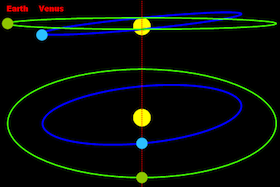The transit of Venus leads to new Earths

Total eclipses of the sun are stunningly beautiful astronomical events, but let's face it: they are not truly rare. A total eclipse usually occurs somewhere in the world every 18 months or so. Next week, however, you may have one last chance to take in a genuinely unusual sight that may have been witnessed (and recognized for what it was) only six times before in history.
It is a transit of Venus -- a romantically evocative name for a phenomenon that played a pivotal role in the development of modern science. Even though astronomers have been intermittently obsessed with it for almost four centuries, they are still making useful discoveries about it. Moreover, the transit of Venus is directly tied to one of the most ambitious and exciting programs in modern science: the search for new Earths and other types of planets around other stars.
If a busy calendar or a mishap of weather or geography prevented you from seeing the last transit of Venus in 2004, do try to watch the one happening on June 5 (or 6, depending on your location). If you miss it, you won't have another chance to watch one live until 2117.
Not quite an eclipse
The transit of Venus is the migration of that planet across the face of the sun as observed from Earth. Because Mercury and Venus are the only planets closer to the sun than Earth, they are the only ones that can transit the sun for us. In effect, a transit is like a distant cousin to the kind of annular lunar eclipse that occurred on May 20.

If the planets of the solar system all orbited the sun in the same plane, a transit of Venus would be ho-hum: Venus's 224.7-day-long year would bring the planet between Earth and the sun roughly every 19 months. But because the orbit of Venus is tilted 3.4° with respect to Earth's, the transits of Venus follow a longer, more complicated schedule. (For the same reason, the moon does not eclipse the sun every month.)
Essentially, transits of Venus are organized according to a 243-year cycle. Within that cycle, transits have occurred at intervals of eight years, 121.5 years, eight years, and 105.5 years throughout the era of modern astronomy, but other patterns applied prior to 1518. In another 800 years, the pattern will have changed again.
When the planets align
In principle, several civilizations with keen interests in astronomy might have known about transits of Venus. Some archaeologists have conjectured that records left by the early Babylonians and Assyrians referred to transits, and it's been speculated that the Aztecs could have seen a transit in 1518, shortly before the Spanish invaded Central America. The general consensus, however, seems to be that no good evidence backs up the claim that any of these peoples saw and recognized transits, and that any dark areas on the sun they reported were probably sunspots.
From the standpoint of modern science, the study of transits began in the early 1600s, while Johannes Kepler was applying his new insight that the planets moved in elliptical orbits. During his tabulation of their motions for his astronomical reference the Rudolphine Tables, he realized that Venus would pass in front of the sun on Dec. 6, 1631 (which would turn out to be the year after Kepler's death) and June 6, 1761. Despite the advance notice, the 1631 event went unseen, however, because it occurred largely at night in Europe.
However, Kepler had missed one. Because of a miscalculation, he didn't realize that there would be a transit visible in Europe on Dec. 4, 1639. That mistake was caught with only a month to spare by 20-year-old Jeremiah Horrocks. He managed not only to see the transit but also to use his observations to estimate that the distance to the sun was 59.4 million miles. His calculation was off by almost 50 percent -- the real value is 93 million miles -- but it was by far the most accurate figure that astronomers had ventured to date. Horrocks's results were published in 1662, 21 years after his own premature death.
What further galvanized scientific interest in the transit of Venus, however, was an insight from the astronomer Edmond Halley in 1716. For observers in different parts of the globe, a transit of Venus would take different lengths of time. Halley realized that from measurements of these times one could precisely reconstruct not only the distance to the sun but, by extension, the orbital distances of all the planets. He exhorted astronomers to make every effort to see the 1761 transit and capture those measurements.
The first global scientific event
Astronomers obliged. One hundred seventy-six scientists mounted expeditions, often under extraordinarily difficult circumstances, to observe the transit from 117 locations in Asia, Africa, and the Pacific. Nick Lomb, author of Transit of Venus: 1631 to the Present, calls it "the first global scientific event." The outpouring of effort continued for the transit of 1769, which included observations from remote areas of Mexico, Canada, and Tahiti -- the latter by Captain James Cook's first expedition.
All those observations did yield far more accurate estimates of the distance to the sun and created a truly calibrated scale for the solar system for the first time, and they were refined still further by studies of the transits of Venus in 1874 and 1882. (No transits occurred during the 20th century.) But their precision was always plagued by a persistent and, until recently, perplexing difficulty called "the black drop effect."
Black drop mystery
From Horrocks's first observations on, astronomers had noticed that near the beginning and end of the transit, when the dark silhouetted disk of Venus was very near the sharp edge of the glowing solar disk, a black drop or smudge would briefly seem to bridge the two areas of darkness. Because this drop obscured the exact moment when the true edge of Venus crossed the solar perimeter, it blunted the accuracy of all the astronomers' subsequent calculations.
A similar illusion appears to the naked eye if you look closely at two fingers that are not quite touching, so astronomers generally attributed the black drop problem to imperfections in the optics of their instruments. To some degree, that does contribute to the problem, and it helps explain why some observers of the 2004 transit of Venus -- who had far better telescopes than their predecessors -- reported not seeing the effect. Something else also seems to be going on, however.
Astronomers Jay M. Pasachoff of Williams College and Glenn Schneider of the University of Arizona saw similar black drop effects in space-based images of transits of Mercury in 1999 and 2003. The effect was consistent with the phenomenon of "limb darkening": namely, that the outermost layers of the sun are cooler than those further in. When a transiting planet blocks a telescope's view of those brighter, hotter regions, the edge of the sun looks darker and appears black. According to Pasachoff and Schneider, observations of the 2004 transit of Venus by NASA's Transition Region and Coronal Explorer (TRACE) space probe showed a black drop effect that was exactly consistent with this limb darkening explanation.
Pasachoff and Schneider's work demonstrates that even though studies of the transit of Venus go back for hundreds of years, there is still more to learn from it. What has really invigorated interest in the phenomenon, however, is its tie to the search for exoplanets, or worlds circling other stars.
Transits of the exoplanets
Astronomers have several ways to look for signs of other planetary systems, such as wobbles in a star's position induced by the gravity of its orbiting planets. But one of the most important methods is based on looking for transits of such planets in front of their stars, as detected by the Kepler space telescope. (The choice of Kepler as the instrument's namesake is not just a generic tribute to a great scientist: it specifically honors his role in kicking off the study of transits.)
During a transit of Venus, the total amount of light received from the sun dips in a characteristic way. With the Kepler observatory, astronomers can look for a similar telltale dip in the light from other stars.
The technique suffers from several obvious limitations. The biggest is that it only works for spotting planets with orbits that happen to periodically block the lines of sight from Earth to their stars. Big planetary systems even a few degrees out of alignment will be unnoticeable.
The technique is also predisposed to notice large planets that orbit close to their suns because those are the worlds with the most frequent and most obvious transits. This is one of the reasons why a large percentage of the exoplanet candidates identified by Kepler so far fall into the category of "hot Jupiters": gas giants with short orbital periods. However, the transit method is much less prone to spotting giant planets than the gravitational perturbation method is, so it is by default also the best available way for spotting more Earthlike planets.
In its survey of roughly 150,000 stars that started in 2009, the Kepler has already found more than 2,300 possible planets. The transit evidence hints that planets are almost ridiculously commonplace, with most stars having at least one on average.
Meanwhile, the 2012 transit of Venus itself will also still be enriching space science. Because the sun is currently in a highly active phase of its 11-year sunspot cycle, observations of this transit should fine tune astronomers' ability to recognize planets around variable stars with naturally inconsistent brightness. By spectroscopically analyzing the light of Venus's atmosphere when it is illuminated from behind, scientists may get a more detailed picture of its composition.
•
How to observe the transit
For anyone who wishes to know how to watch the transit of Venus, some obligatory safety notes are in order. As with an eclipse, never stare directly at the sun with naked eyes or you risk permanent blindness. Don't trust ordinary sunglasses, either. Specialized solar filters from reputable astronomy supply houses offer real protection. A safe, easy, and inexpensive way to watch, however, is to project the image of the sun onto a screen or sheet of paper with binoculars, a telescope, or even just a pinhole in a piece of cardboard. Or if you prefer to savor a more vicarious experience, you can watch the live coverage of the event online on NASA TV, beginning at 5:30 p.m. EDT on June 5.
•
For further information, consider:
Transit of Venus: From 1631 to Present, by Nick Lomb (The Experiment, New York, 2012) is a lavishly illustrated and entertaining history of the phenomenon. The book was first published in 2011 in Australia but a new softcover edition for North America was just released. Lomb's book was an invaluable resource during my research for this column.
"Sic Transit Venus," by Jennifer Ouellette, on the Cocktail Party Physics blog for Scientific American, is a delightfully written summary of the transit's history that goes into much more detail about the some of the amazing stories connected to the 18th-century events. She also describes the upcoming experiments that will use the Hubble space telescope to capture light from Venus that bounces off the Moon during the transit. (What an astonishing idea!)
TransitofVenus.org aims to be your online one-stop-shop for all things transit-related.
And for anyone with a lot of idle curiosity or an interest in making extremely long-term plans, here is a catalog of 81 transits of Venus falling between 2000 BCE to 4000 CE.
•
Top image: The 2004 transit of Venus, as captured by NASA's TRACE satellite. The thin red line around the planet is the atmosphere illuminated from behind. (Credit: NASA)
This post was originally published on Smartplanet.com
